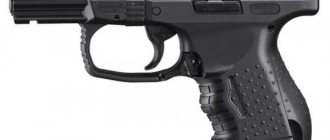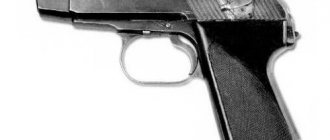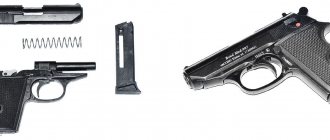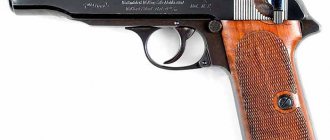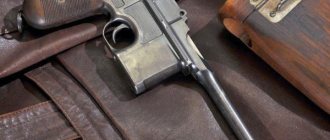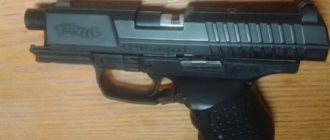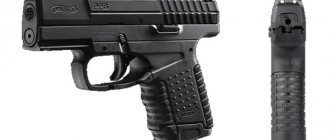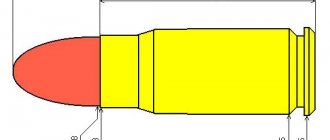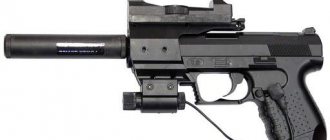Traumatic weapons belong to one of the types of civilian weapons, and therefore become a constant topic for discussion in various forums on relevant topics. Despite expectations of statistical equilibrium regarding the number of citizens owning firearms of limited destruction, their number is steadily growing. There are a number of reasons why there is a desire to purchase personal injury equipment. Is this both collecting and banal emphasizing status? The main reason is to ensure your own safety.
The first step to purchasing a weapon, in addition to obtaining permits, is to analyze the characteristics of the presented models. Since everything is learned by comparison, every potential buyer wants to know how a particular model compares favorably with others. Articles that provide an overview of today's popular traumatic weapons will help answer this question in detail.
First acquaintance with the Walther P22T pistol
The Walther P22T traumatic pistol is certified in Russia as a gas weapon. But there is a special note that rubber bullets can be used. The caliber of cartridges used is 10x22T.
This model received the secret name “Rubber Walter” precisely for its ability to fire rubber bullets. However, high-strength polyamides have found their use in the manufacture of pistols. The frame is made from this material.
The Walther P22T was not created from scratch, but based on one of the versions of the small-caliber P22 pistol from the Walther company. This is a ten-shot weapon intended for target practice. The injury looks very much like the popular combat Walther P99. But the similarity is only external, since there are significant differences in the design. The trigger principle of constructing the trigger mechanism of the P22 model assumes the presence of a non-automatic fuse that separates the trigger and the firing pin. The power of the .22LR cartridge is sufficient for automatic self-cocking to operate when the bolt recoils. Therefore, the double-type trigger operates in one of two modes: self-cocking or cocking.
Performance characteristics of Walter PPK
— Designer: Walther — Developed: 1931 — Adopted: 1935 — Manufacturer: Walther — Total produced: more than 1 million.
Wes Walter PPK
Dimensions Walter PPK
— Length, mm: 155 — Barrel length, mm: 83 — Width, mm: 25 — Height, mm: 109
Walter PPK cartridge
- 7.65×17 mm - 9×17 mm ("kurts") - .22LR, - 6.35×15 mm
Walter PP bullet speed
— 280 m/s for 7.65×17 mm
Walter PPK magazine capacity
— magazine for 7 rounds of 7.65×17 mm — 9 rounds of .22 LR
Sight: constant Operating principles: blowback recoil.
Components
The sighting device has a classic structure. The front sight remains stationary, and the rear sight can be adjusted horizontally. In the front of the frame there is a special mounting part that allows you to install a laser sight or flashlight. There is a replaceable pad on the back of the handle. It has different dimensions, and the shooter can choose the most suitable option for him. Similar elements could be observed in the P99 model. The quality of aiming and the comfort of shooting depend on a high level of ergonomics, and the pads make it possible to choose a girth that is convenient in terms of dimensions.
The developers paid a lot of attention to the security system and protection against spontaneous shooting. In addition to the safety lever that blocks the firing pin, the pistol is equipped with a mechanical switch. It is operated only with a proprietary key. The lock prevents the trigger from moving. To remove it, you need to use a key, since no other available means are suitable for this. Despite the presence of double protection, it is recommended to follow all safety precautions when carrying a pistol.
The model index contains the letter “T”. Some are inclined to believe that it denotes the type of weapon - traumatic. In fact, this is how a modification produced specifically for the Russian market is labeled. But since in this modification the barrel is modified to fire rubber bullets, this index can be associated with trauma.
The peculiarity of the barrel design is that immediately after the inserts that prevent the use of a live cartridge, the bullet begins to move along the false barrel in the gas flow, while the rubber ball practically does not touch the walls of the barrel. The barrel diameter, increased compared to the size of the ball, significantly reduces the friction force, which leads to an increase in muzzle energy.
The manufacturer guarantees a high accuracy rate at a distance of no more than 5 meters. If you fire 4 targeted shots, the dispersion width will be only 4 cm. Models with such accuracy are quite suitable not only for use as a means of self-defense, but also as educational, entertainment and sports weapons. Of course, the power of a rubber arrow cannot be compared with the power of a real sporting weapon, but it is more realistic to buy a trauma weapon than other types of powerful weapons.
Ammo
For the Walther P22T model, cartridges with a caliber of 10 mm were developed. Their name is 10x22T. The destructive element is a rubber ball weighing 0.7 g. The relatively low muzzle energy fits the model into Russian legislation. But this small indicator is not a design flaw. Most likely, it indicates low-power cartridges.
The Walter traumatic pistol is not considered universal, since it is designed only for the specified cartridges. It is known that some models can fire signal or sound cartridges.
History of creation[edit]
In 1931, a shortened and lightweight model Walther RRK (short for Polizeipistole Kriminal
, German
Criminal Police Pistol
), which was a PP reduced in size, but also had some original design features. The barrel length was reduced by 15 mm, the overall length by 16 mm, and the height by 10 mm. Accordingly, the design of the frame and the shutter-casing was slightly changed, receiving a different shape for the front part.
After the war, pistols were not produced for some time, but in the early 1950s they began to be manufactured in France and Germany.
In the 1960s, it resumed production of the PP and PPK models, which continued until the end of the twentieth century.
In addition, the production license was sold to the USA, in 1978 the production of pistols was started for, and after its closure, in 2002, the Smith & Wesson company.
General issues
Original holsters are supplied to Russia along with the pistol. But if it is not possible to purchase it, then you should look for an analogue in a weapons store. By the way, choosing a suitable holster for Walter is not so difficult. On top of that, some Russian companies are starting to produce components for traumatic Walters. It is known that cartridges will be manufactured in Novosibirsk.
The mechanical safety key holes are located just above the trigger. They are marked with the letters "S" and "F". When the cartridge is in the chamber, you can feel the ejector, which protrudes above the bolt. This is very convenient as it allows you to determine whether the weapon is ready to fire or not. The magazine snaps into place conveniently. The latch lever is located centrally near the trigger guard. This lever can be turned with either the left or right hand. The pistol is uniquely designed for both right-handers and left-handers.
At the beginning of the article it was stated that the Walther P22T pistol was certified as a gas weapon capable of firing rubber bullets. This move was made in order to sell the products in Russia, because according to existing laws, it is allowed to store and use only domestically produced trauma products. Before receiving the certificate, it was decided to begin production of the Escort pistol at one of the domestic enterprises. But since there are no such requirements for gas weapons, and Walter is positioned specifically as a gas weapon, we managed to sort out the legalization.
Operating countries[edit]
Select a country or scroll your mouse wheel
French "Walther-Manurhin".
- Germany - from the moment of its creation, the West German police received Walther PP and Walther PPK pistols, produced in the Third Reich, and later a batch of 7.65-mm French-made Walther-Manurhin pistols; Since 1956, the production of Walther PPK for the Bundeswehr began under the name P21 (used by the military police, military counterintelligence service (MAD), military aviation pilots and couriers). Weimar Republic
- Walther PP and Walther PPK were in service with the police. - Third Reich
- Walther PP and Walther PPK were in service with the police and intelligence services, used as personal weapons by tank crews, Luftwaffe and German Navy officers, senior Wehrmacht officers, a certain number were transferred to the Reich Ministry of Justice as personal weapons for employees . Since 1944, Walther PP began to be issued to graduates of Wehrmacht officer schools. Also, Walther PP and Walther PPK were used as award weapons for the highest ranks of the Third Reich.
) - captured pistols were used during the Great Patriotic War; in the first post-war years, a small number of Walther PP and Walther PPK pistols were used in the diplomatic courier service, a number more were transferred to award funds and were used as award weapons. Also, a number of pistols were handed over to the SMERSH troops.
In addition, even before the outbreak of World War II, pistols went on sale as civilian weapons and became widespread in various European countries.
Model characteristics
Technical characteristics are presented by some parameters that you should pay attention to when purchasing any pistol. If you collect all the data together, you can make a list of the most important characteristics.
- Cartridge caliber – 10x22 mm.
- Weight of an unloaded barrel – 430 g.
- The trigger force when shooting with pre-cocking is 2 kg.
- The trigger force in automatic mode is 5 kg.
- The number of cartridges that fit in the magazine is 7 pieces.
Interesting facts[edit]
- 7.65 mm PPK - weapon of James Bond, agent 007.
- N.F. Makarov, a Soviet weapons designer, was inspired by this pistol and subsequently created his famous PM pistol, which is a bit like the PPK.
- This gun is used by Andy Barclay to kill one of Chucky's "clones" at the end of the film Cult of Chucky. However, when he tried to shoot Nika, who had already been possessed by Chucky, he ran out of ammunition (although the Walther PPK has from 7 to 9 rounds, and Andy only spent 5).
- In a series of parody films about super-spy Austin Powers, the chrome-plated Walther PPK serves as the agent's main weapon.
- This pistol is used by the main character of the animated series "Special Agent Archer".
Advantages and disadvantages
When identifying advantages or disadvantages, you can rely on the opinions of owners who leave reviews on various forums. We do not encourage you to evaluate each factor as objective, however, such reviews often help inexperienced and novice amateurs make their choice.
Let's start with the positive qualities that cannot be ignored.
- External weapons look very convincing, as they have real “combat” roots.
- The relatively small weight is a very significant argument, considering that the barrel will have to be carried with you at all times.
- The triviality of shooting manipulations turns trauma into a learning tool for beginners.
- Pistol cartridges are not in short supply and are affordable.
The disadvantages of the model follow from its advantages. The low mass indicates that only a portion of metal products were used in the design. For a muzzle energy of 50 J, the reliability of the barrel is within normal limits, however, when trying to use more powerful cartridges, the integrity of the pistol is called into question after 20-30 shots.
The bump stop bracket is made of plastic. Naturally, it quickly wears out, which leads to the shutter coming off the guides. The pistol requires careful and timely maintenance. Dust and dirt can cause the firing mechanism to jam. In terms of power, Walter is inferior to many of his “classmates”, since, in fact, he belongs not to the class of firearms, but to gas weapons.
Purchase procedure
If you have a license to purchase limited-kill firearms, buying a Walter will not be difficult. Even the fact that it is certified as a gas pistol does not make leniency in terms of the legality of the transaction. Therefore, you should trust only those suppliers who require a license. They do not hide the fact that the only way to pick up weapons is self-pickup. Transport companies have the right to transport weapons only with permits.
The price for a barrel is about 4-6 thousand rubles. It is this that has become an attractive factor for the Russian consumer, since it is several times lower than the cost of domestic trauma.
